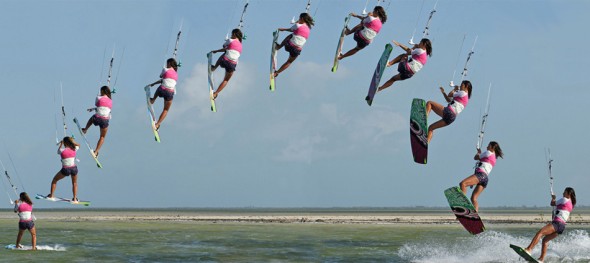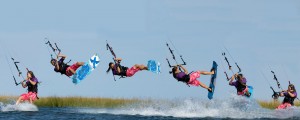Nose Grab Jump
Today we have this new trick which is Nose Grab Jump. Jump variations and grabs are always welcome as they add something to the most fundamental of moves without, hopefully, the need to hammer yourself too much in the process. It’s always a delight to see someone boosting and banging out numerous different grabs, making each jump different and the whole performance more pleasing to the eye. This time around it’s the nose grab, the most opposite of the most common but deservedly adored tail grab. This one is a great way to show off your board and any promotional stickers adhered to it as with the majority of jumped grabs you’ll be grabbing the nose with your back hand whilst keeping the kite flying and yourself hanging with your front hand. All that you need is a half decent take off and if you’re already comfortable grabbing anywhere else and freeing your back hand then you’re ready.
After Take Off Pic A.
Assuming that you can jump directly after take off check your balance and then casually grab the tail. To grab the nose from your big chill position with both knees up will be very difficult unless you’ve been hard at the yoga.  As a result there are a couple of points worth your consideration.
As a result there are a couple of points worth your consideration.
No-1 is a good positive kite send, with a decent pull and push on the bar to get the kite moving back past 12. Going up with the kite behind you will rock you back and as a result bring the nose of the board up. Secondly bring your front knee up towards you. Thirdly leave your back leg straight. And finally aim to get the grab in on the way up, before you redirect the kite so that the bar is not in your way. In the photo straight away after takeoff, the rider’s kite is behind her and as a result her legs are penduluming up in front of her, much like those early days of trying to jump but forgetting to bring the kite forward. Her shoulders are leaning back and her front knee is lifted.
Go for it Pic B.
As mentioned, going for the grab early is key to reaching the nose of your board without being made of elastic . In this image the rider extends her back arm towards the nose whilst bringing her front knee right up towards her chest and extending her back leg down and away from her. You can see that she is still leaning back and that the kite is still behind her, and therefore even though the bar is sheeted in, it’s not in her way. She reaches for the board by leaning back and twisting her back shoulder around behind the chicken loop, and not by leaning forward towards the nose.
. In this image the rider extends her back arm towards the nose whilst bringing her front knee right up towards her chest and extending her back leg down and away from her. You can see that she is still leaning back and that the kite is still behind her, and therefore even though the bar is sheeted in, it’s not in her way. She reaches for the board by leaning back and twisting her back shoulder around behind the chicken loop, and not by leaning forward towards the nose.
Use Your Hands Pic C.
Once the job is done and you’ve reached your grab your hands will do the rest of the work. The rider has grabbed  her board firmly and holds it, pulling it towards her, which helps her to keep this position for as long as possible. With the board held close she can now also redirect the kite to around 12 to get some support and hang. You can see that she has given the bar a hefty pull, and this is on a 7m, to get the kite back up and parked so that she stays up and floats.
her board firmly and holds it, pulling it towards her, which helps her to keep this position for as long as possible. With the board held close she can now also redirect the kite to around 12 to get some support and hang. You can see that she has given the bar a hefty pull, and this is on a 7m, to get the kite back up and parked so that she stays up and floats.
In Flight Entertainment Pic D.
As with all grabs they’ll look better if you hold them on the way down. This does however mean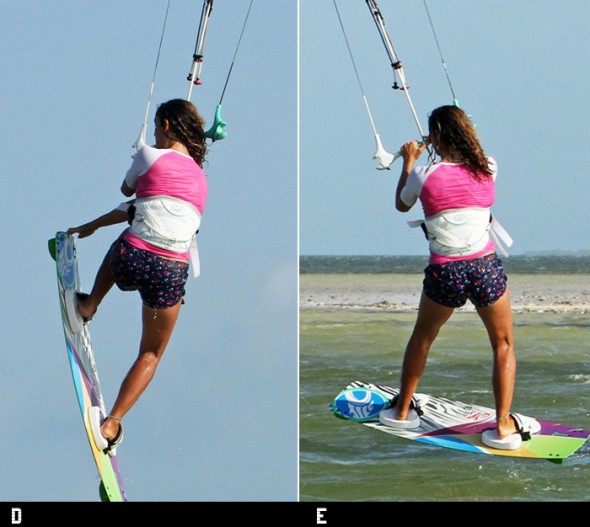 that you’ll have to get the preparations for landing set with one hand! Having sent the kite hard you have the advantage of being able to lean on your front hand throughout this move, once you’ve got the grab, without the kite diving aggressively. However as you come down if the kite drifts slowly around the edge of the window you will have trouble finding power to land, so you’ll need to get it moving through the window as you descend. In this picture the rider is holding her grab but has started to pull hard on her front hand to get the kite moving and ready to dive.
that you’ll have to get the preparations for landing set with one hand! Having sent the kite hard you have the advantage of being able to lean on your front hand throughout this move, once you’ve got the grab, without the kite diving aggressively. However as you come down if the kite drifts slowly around the edge of the window you will have trouble finding power to land, so you’ll need to get it moving through the window as you descend. In this picture the rider is holding her grab but has started to pull hard on her front hand to get the kite moving and ready to dive.
The Landing Pit E.
Now in final the landing should be as for any other jump. We can see that in anticipation the rider has dropped her grab and let her legs fall underneath her. With two hands on the bar she can dive the kite and keep the power on by keeping the bar in. As the kite pulls she goes with it aiming to land tail first with the board pointing quite downwind. Landing over the board she can then carve back onto her edge and set up for the next one.
Top Tips
- The best tip is to start off by trying some jumps with a decent push and pull, to find a comfortable equilibrium between leaning back and staying in control, as you don’t want to be swinging way up with your kite stuck down behind you.
- Now let’s talk about 2nd best tip, once you’re comfortable with this try bringing your front knee up and straightening your back leg. Finally once you’re confident get the back hand off soon after takeoff and twist round for the grab.
Common Problems
- If you’re penduluming up and crashing down onto your back your take off is catching you out. You can only send the kite hard if you keep your edge until you lift off. If you’re losing your edge or letting the bar out before lift off your kite will fly too far back. If this is the case calm the send down a notch or two.
- If you can’t reach the grab, you’re either going too late or reaching forward for the nose. Lean back and twist round. That said if your foot-straps are too tight, it can be difficult to lift the front knee and straighten the back leg, as your feet need to roll in the straps slightly.
Keystones
- Good edge and positive send back
- Lean slightly back and lift front knee
- Straighten back leg and twist around for grab
- Hold board in and redirect
- Release and dive hard for landing
Popped Front Loop
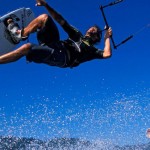
It’s always good when you have the chance to learn something that looks exquisite; the hooked in Popped Front Loop is such a cherub. Even when it is too windy to show off all the technical tricks in your armory, this adds up with a cheeky Indy Grab that will keep most of the pop fanatics happy. It is a great way to get your head around an unhooked popped front and it is a welcome alternative to a sent jump front. It will work on the flat off a wave and because you can control the power in the kite, even the chop won’t stop you.
The essence of any pop trick is that all your upward force comes from you alone, with no help from the kite. However the position of your kite will affect how much height you get. The nearer it is to 12 o’ clock the more lift you will have. So it stands to a reason that if you are learning this move, you should have the kite around 11 o’clock. This way the kite will be just low enough that you can edge against, but it will also be high enough to give you some bonus lift and assist with getting your board back under you.
IMPORTANT STAGES
The Approach
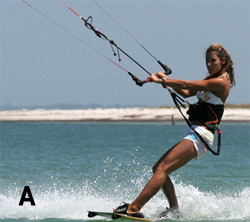 As you won’t be using the kite for the lift, you will need some quickness and speed so you can pop hard. Assuming that you popped, you will already know that generating your speed can be increased by heading slightly off the wind with the power of your kite. Just try and change your direction smoothly by steering the board in front rather than standing up on it.
As you won’t be using the kite for the lift, you will need some quickness and speed so you can pop hard. Assuming that you popped, you will already know that generating your speed can be increased by heading slightly off the wind with the power of your kite. Just try and change your direction smoothly by steering the board in front rather than standing up on it.
Pic A – Shows that the surfer is in a perfect pre-pop position. The kite is on 11 o’clock direction and has steered the surfer’s board off the wind by the feet’s extension. To maintain a good stance, you need to push your front leg out and move your hips back behind your back foot. Your shoulders should be still behind your hips and the board is still in between you and the kite. Keep your hands on the center of the bar to prevent any unwanted kite movement. Here you can acquire speed that will give you an attempt to carve back onto your edge.
The Carve
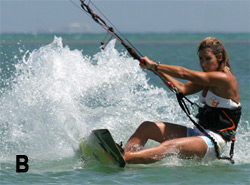 This isn’t the moment to consider on as in reality it only lasts a split second. However your body position here is the important thing because it defines the amount of pop that you will get. Visualizing it first and foremost can be of benefit.
This isn’t the moment to consider on as in reality it only lasts a split second. However your body position here is the important thing because it defines the amount of pop that you will get. Visualizing it first and foremost can be of benefit.
Pic B – Best Place to start is the surfer’s kite face. To get a decent pop and enough rotation, you need a bit of an effort and aggression to go up. Next see how close the surfer has his derriere to the sea. This is only possible because of the position taken into the pop. With the surfer’s weight back and upwind, it is easy enough to get back on the edge by turning suddenly on upwind. Using your shoulders to twist your body around your hips for the board turn can give you a quick flexibility for the move. See that the back leg of the surfer is flexed and ready to extend, and the front leg extension keeps the surfer’s board on edge. As soon as you get into the position, you must be ready to pop up or else you will lose speed. Final point here is not to pull on the back hand.
The Take Off
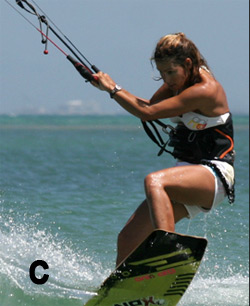 As you know from a front loop, the take-off is everything as it initiates the rotation. It also needs to give you pop so the trick is to fire yourself into the rotation without flattening the board off.
As you know from a front loop, the take-off is everything as it initiates the rotation. It also needs to give you pop so the trick is to fire yourself into the rotation without flattening the board off.
Pic C – shows that the surfer explodes for the take-off. You can see how the back leg extends against the resistance of the edge of the board, thus pushing the body up. However unlike a sent front loop, it doesn’t throw across the board towards the sea on the other side, as this would flatten the board. Instead the surfer throws his head towards the nose of the board allowing a bend sideways at the waist. This stage is enough to start the rotation. Faith is the key.
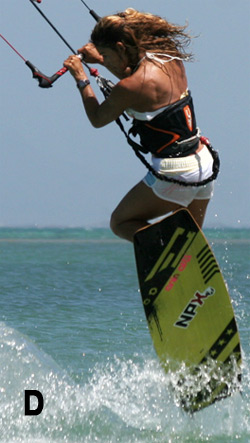 Pic D – Clearly demonstrates the commitment to the pop. As the surfer goes up, bar-in is the one you should keep in mind because if you do so, rotation can be easy in middle lines. See the surfer’s front hand as his steering connection slows down the kite to make sure it doesn’t drift up. The surfer is now in a textbook position to throw the rotation. With your back leg extended and front leg bent combined with your weight down, your next step is to forward now to speed up your rotation and turn your head to look back over your trailing shoulder and bend your back leg.
Pic D – Clearly demonstrates the commitment to the pop. As the surfer goes up, bar-in is the one you should keep in mind because if you do so, rotation can be easy in middle lines. See the surfer’s front hand as his steering connection slows down the kite to make sure it doesn’t drift up. The surfer is now in a textbook position to throw the rotation. With your back leg extended and front leg bent combined with your weight down, your next step is to forward now to speed up your rotation and turn your head to look back over your trailing shoulder and bend your back leg.
Pointers to Consider
It is highly recommended practicing kiting across the wind with a speed before bearing away and then turning up again to concentrate on your body position. Once you have done this a few times, just add the pop off the back leg and you will find that popping hard with your front shoulder is actually easy. If you lose balance, most likely you are not bearing away enough before carving hard. The more downwind you start the less far you have to rotate.
The Trick in Sequence
1-2. Notice the surfer keeps the bar in close, keeps the kite steered forward and throws his head and shoulders down towards the nose of the board. Now that the board is clearly off the water, the surfer needs to rotate faster.
3. The surfer quickly turns the head to look back over his rear shoulder.
4-5. As long as the surfer keeps the bar the kite steered forward while he keeps looking over the shoulder, the rotating will continue to go.
6. Once the surfer can see the water, the concentration will be on where to land.
7-8. As the surfer’s leg comes around, the extension of the legs should be ready for landing. Aiming to land the tail first, pointing downwind on a flat board and not on the edge the surfer carries a fair amount of speed. As long as the tail lands first, the board can pivot further around and downwind.
9. The surfer lands, absorbs the impact and keeps head up looking where to go with balance in hand. The surfer has the bar in and the kite steered forward always.
Key Marks
1. Speed, off the wind
2. Weight back over tail off board
3. Carve hard, pop up and forward
4. Steer the kite down
5. Flick! Good job!
Here´s what it will look like!
Airgybe to Toeside
The airgybe to toeside is a trick that makes turning much more fun. Instead of just stop and change direction, you jump and fly around in a U-turn.
When you do this trick come in with moderate speed, since it will be damn hard to take the landing in high speed. Keep the kite at 11:15 or 14:45 and to make sure that you come in with to much speed, carv hard up wind, so when you pop out of the water you fly up and not forward like in a normal jump.
Once airborn let the kite pull you upwards and keep the bar close to your hip. When you feel that you´re on your way down, steer the kite aggressively in the opposite direction at the same time as you rotate your hip. Spot your landing, point the board downwind. When you land carve upwind on your toeside edge, that’s it!
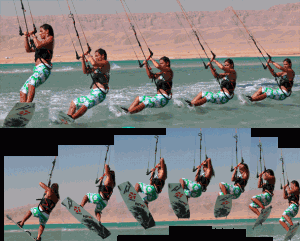
Pop Back Loop
The pop backloop is often the first kite trick that kiters learn and once you master it you’ll be eager to learn more advanced tricks.
To perform this trick there are a few key points you must follow:
- Speed. You need speed or else the board will stop in the water when you edge hard upwind.
- To gain speed you’ll have to momentarily point your board downwind, just before you start edging upwind.
- You will be physically jumping up off a coiled back leg, whilst edging the board, corking yourself up and out of the water.
- You will not use the kite for a lift, so park your hands close together on the bar. This means that you’re sailing with kite at 11-11:30 or 12:30-13:00. Having the kite heigher will give you more lift.
So, you’re are mentally prepared and you’re ready to start the backloop pop. Now follow these steps.
- Ride upwind.
- Relax your legs, so that you’re not pushing the board away from you and kite downwind a few meters.
- Once you gained enough speed, start carving quick against the wind, up to almost 45 degrees across the wind.
- At this point push the board away from you with your legs and turn your shoulders back up the wind. This will initiate the rotation.
- Keep turning away from the kite and you’ll continue the rotation in the air and hopefully land nice after turning about 270 degrees (the first 45 degrees are performed with the board still in the water).
- That’s it.
Hooked Backroll
For many kiters, the hooked backroll is their first real kite trick to master. It’s easy to learn and you don’t rip yourself apart and together if you fail and crash, so the hooked backroll is a good trick for beginners. So, how do you perform it? Easy, just do like this:
- Keep your kite at 45 degrees and enter the trick with moderate speed and power.
- Edge very hard and pop out of the water and throw your feet at the sky above your shoulder.
- Just as you come of the water turn your head and try to look over your shoulder in the direction of the spin.
- Keep looking over your shoulder until you spot the water.
- focus on the spot where you want to land.
- Bend your knees, point the board downwind and land.
- Continue your ride!
Tips! Keep looking over your shoulder, if you stop looking you will stop spinning. Keep your hands in the middle of the bar. Stay relaxed, if you spin to hard, it is going to be very hard to land without slipping out. At first if you cannot get the full rotation, then try to bring the kite lower.
